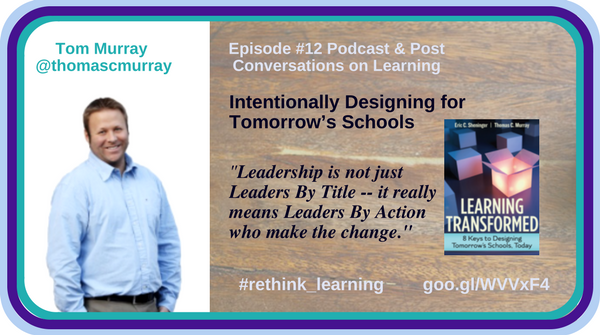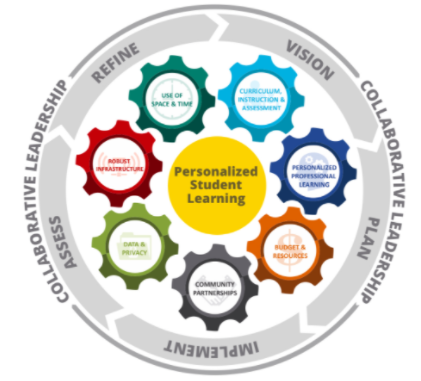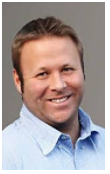
Podcast: Play in new window | Download
Subscribe: Spotify | TuneIn | RSS
Tom Murray serves as the Director of Innovation for Future Ready Schools, a project of the Alliance for Excellent Education, located in Washington, D.C. and is co-author of the new ASCD book, Learning Transformed: 8 Keys to Designing Tomorrow’s Schools, Today.
I’m fortunate to have met Tom and learn so much from his presentations and keynotes. He sent me a copy of his and Eric Sheninger’s book, Learning Transformed, for me to review. What a valuable book for schools! I feel so honored that Tom shared his journey to transform learning with me. Below are a few excerpts from the podcast, Tom’s contact information, and a recent webinar with Tom and Eric.
Can you share a little about you, your family, and your former life as a teacher and principal?
My family is the reason why I do the work I do. When I do keynotes or presentations, I start with pictures of my family, my babies. My little girl, Paisley, is a second-grader at a public school in Pennsylvania at a wonderful district, Parkland School District. My little boy just turned four. They are the lens that I do what I do. I look at what would I want for my own kids. If it’s good enough for my kids, it’s good for every kid. I’m not this 50,000-foot policy person that’s never done what I’m talking about trying to tell school leaders what to do. I spent 14 years in public schools in Pennsylvania first as a teacher, a number of years in 4th grade and taught middle school for a couple of years. I became a middle school principal and then an elementary school principal for three years. After that, I moved to the district office where I was the Director of Technology and Cyber Education.
How did you and others start #edtechchat?
 You know #edchat was around along with other great Twitter chats and I was asked to guest moderate several chats talking about Ed Tech. About 5 years ago, I talked to Katrina Stevens @KatrinaStevens1, Susan Bearden @s_bearden, Sharon Plante @iplante, and Alex Podchasky @ajpodchaski on a Google Hangout one day where we asked, “what if we started a chat around Ed Tech?” We decided it was not for the purpose of talking just about tools or devices, but to focus on learning and the effective use of Ed Tech. On our first chat, we had no idea how many would join us and over 100 people showed up. Our team has expanded over the last few years with 9 or 10 of us running the chat. We’ve had guest moderators with people from superintendents to teachers and some like Arne Duncan which was his first Twitter chat to ever moderate when he was Secretary of Education. We avoid the sales pitch side of things because we want to talk about learning and hear from teachers and other educators. #edtechchat is on every Monday night from 8-9 EST and hope to see people there.
You know #edchat was around along with other great Twitter chats and I was asked to guest moderate several chats talking about Ed Tech. About 5 years ago, I talked to Katrina Stevens @KatrinaStevens1, Susan Bearden @s_bearden, Sharon Plante @iplante, and Alex Podchasky @ajpodchaski on a Google Hangout one day where we asked, “what if we started a chat around Ed Tech?” We decided it was not for the purpose of talking just about tools or devices, but to focus on learning and the effective use of Ed Tech. On our first chat, we had no idea how many would join us and over 100 people showed up. Our team has expanded over the last few years with 9 or 10 of us running the chat. We’ve had guest moderators with people from superintendents to teachers and some like Arne Duncan which was his first Twitter chat to ever moderate when he was Secretary of Education. We avoid the sales pitch side of things because we want to talk about learning and hear from teachers and other educators. #edtechchat is on every Monday night from 8-9 EST and hope to see people there.
Can you tell me about your work with Future Ready Schools?
After 14 years at my district, I have been the Director of Innovation for Future Ready Schools for the past three years. I get to work with school leaders from coast to coast running events for hundreds of leaders encouraging them to network, collaborate and share best practices or it could be running leadership retreats or being at conferences where I often see you around the country. Under the scope of my role, I see schools in some of the poorest areas in our country and visit the urbanest areas. I’ve truly grown as an educator and learned as much in the last 3 years as I did in my first few years as a brand new teacher as well.

Copyright: Future Ready SchoolsⓇ
What does it mean for a district to be Future-Ready?
My home organization where I work in Washington DC is known as the Alliance for Excellence Education. They are a bipartisan, nonprofit group whose work is really focused on student achievement and helping kids to get to graduation. One of our core themes is equity for all students to have the same access like I did growing up in suburbia. I recognize my privilege. That’s part of my passionate reason to help all kids so they have similar experiences as I did. So the Alliance does a lot of work on the policy side and helping write about ESSA from a bipartisan view. However, Future Ready is not just the Alliance. It is a collaboration between over 60 organizations from places like ISTE and COSN to organizations like AASA for Superintendents and NASSP for principals to teacher organizations like AFT and NEA. Future Ready does not have a sales pitch. It is grant-funded in a variety of different ways along with corporate sponsors through their foundations. What we do is take all the work we are doing and trying to move it forward to connect and collaborate free for school districts
The first two years for Future-Ready were focused on district leadership because we always believed there were pockets of great things going on in schools. To scale the work, district leadership needs to be on board. There are over 3100 district superintendents representing over 21 million children who already signed our Future Ready pledge. Future Ready (futureready.org) just launched 5 strands this year. So now there are Future Ready Superintendents, Principals, Librarians, Instructional Technologists, and Instructional Coaches. Each of these strands has its own Facebook pages. A workshop for 10 to 15 principals is run by principals. Same for the other strands with people who have been there shaping the content and experiences to make it real for the participants. The idea is to move our schools forward with our kids at the heart and center of the decision-making.
I’ve read your amazing new book, Learning Transformed that you co-authored with Eric Sheninger. I really appreciate how you both got to the heart of what matters most for our kids. Why did you start in your introduction with “A Sense of Urgency?”
 Eric and I are blessed to work not only in keynotes but closely in workshops with thousands of school leaders every year. We see the really hard issues they are struggling with that are on their plates. Some of those issues are equity, access, and even budget cuts. We wanted to put a book together that were the common themes and struggles we are seeing and where the schools are that are truly transforming learning. So you asked why we started with “A Sense of Urgency?” To create that compelling “WHY” and to put that hook out there. What is the need to transform?
Eric and I are blessed to work not only in keynotes but closely in workshops with thousands of school leaders every year. We see the really hard issues they are struggling with that are on their plates. Some of those issues are equity, access, and even budget cuts. We wanted to put a book together that were the common themes and struggles we are seeing and where the schools are that are truly transforming learning. So you asked why we started with “A Sense of Urgency?” To create that compelling “WHY” and to put that hook out there. What is the need to transform?
Part of the reason we did that is that it is easy to become myopic looking only in our building, school, or district. Eric and I see the vast inequities that exist for places like our females in areas of STEM or opportunities for our students of color. Three things we considered in our book. (1) How do we handle all of those pieces? (2) We wanted to create an awareness of those issues. (3) Everything needed to be grounded in research with evidence.
Schools tend to hop on the latest bandwagon and trend to spend all their money. Then they look back and see that it didn’t even do anything. We have to be better stewards of our spending, especially if is coming out of the taxpayer’s wallet. As leaders, we have an obligation to spend the taxpayers’ money well. But more importantly, we have to create robust learning experiences for kids. Part of that sense of urgency is helping people understand what the world of work is projected to look like. My little girl going into second grade and will be in the high school graduating class of 2028. My little boy will be in the class of 2032. So what will the world of work look like in 2036 when my boy graduates from college? That’s almost 20 years from now. That’s the reality of the future for my family, and that becomes urgent for me. That’s my lens. But in our roles as educators, we need to create that sense of urgency to prepare all children for their world, their future.
We have to look at what that world will look like for them. Eric and I referenced about 190 research reports to ground what we wrote in evidence. We wanted to provide research so learners can be successful in their future world of work. For example, they are projecting that there are 4-5 jobs today that pay under $20/hour that will eventually be automated. If those predictions come true, what happens to our economy and the people involved? What does that mean for the world of work? That’s where we need to focus on teaching and learning since we are shaping those students that will be leading that future. That’s truly why we have that sense of urgency.
How do you take the evidence grounded in the WHY and compare it to traditional practice happening in your school or district? We found schools and superintendents with innovative practices in action (IPA) that back up what they are doing and aligning it to the research. We wanted to move from the evidence to the practice in every chapter.
You mention intentionally designing for tomorrow’s schools. The 8 keys provide evidence-based practices and innovative ideas to provide a dynamic, blueprint for redefining student learning. Is that why Key #1 is Leadership and School Culture to lay the Foundation?
We are very purposeful with leadership in schools and culture as setting the tone. Eric and I have been in some of the poorest areas, in fact, I was in a place in Mississippi that was still on dial-up. Here’s the thing, we’ve seen some of the poorest areas do amazing dynamic things with kids. Why? Because of school leadership. Then we see other areas where they have more than enough technology but they are still teaching the way they used to teach years ago. There are kids who are compliant and play school really well so they do well in school. The difference comes down to leadership. I’ve never seen districts that do amazing things without dynamic leaders.
Leadership may mean that the best leaders could be the 5th-grade teacher or a support staff member that are leading the way. It is not just LBT (Leaders By Title) — it really means Leaders By Action who make the change. Leadership and school culture lay that foundation. You can have the greatest plan but if you have a toxic school environment, it will fall apart. Another theme in our book that matters for culture is relationships. How do we form and cultivate those relationships? That is the heart and soul of transformation.
****
I hope you listen to the entire podcast with Tom for the rest of our conversation. Tom is so passionate about transforming teaching and learning and that comes across in the podcast. This was an amazing opportunity for me to have this conversation with him about his and Eric’s amazing book. I captured excerpts of our conversation in the post above but there is more so don’t miss it. He continued to discuss information on student agency as a valuable component for the “Netflix Generation,” why it is important to avoid the “Cemetery Effect,” and design learner-centered environments, and brought it all back to why we need to transform learning: it’s all about our kids. I highly recommend every educator who believes it is time to transform teaching and learning to read Learning Transformed.
****
 Tom Murray has testified before the United States Congress and works alongside that body, the US Senate, the White House, the US Department of Education and state departments of education, corporations, and school districts throughout the country to implement student-centered, personalized learning while helping to lead Future Ready Schools and Digital Learning Day. Murray serves as a regular conference keynote, was named the “2017 Education Thought Leader of the Year,” one of “20 to Watch” by NSBA in 2016, one of the top 20 thought leaders in education, and was named the “Education Policy Person of the Year” by the Academy of Arts and Sciences in 2015. His new book, Learning Transformed, co-authored with Eric Sheninger and published by ASCD, was released in June 2017.
Tom Murray has testified before the United States Congress and works alongside that body, the US Senate, the White House, the US Department of Education and state departments of education, corporations, and school districts throughout the country to implement student-centered, personalized learning while helping to lead Future Ready Schools and Digital Learning Day. Murray serves as a regular conference keynote, was named the “2017 Education Thought Leader of the Year,” one of “20 to Watch” by NSBA in 2016, one of the top 20 thought leaders in education, and was named the “Education Policy Person of the Year” by the Academy of Arts and Sciences in 2015. His new book, Learning Transformed, co-authored with Eric Sheninger and published by ASCD, was released in June 2017.
Tom’s Contact Information
Twitter: @thomascmurray
Twitter Hashtags: #lt8keys #futureready
Website: http://thomascmurray.com/
Co-founder: #edtechchat
Links:
Co-author, Learning Transformed: 8 Keys to Designing Tomorrow’s Schools, Today (ASCD 2017); Study Guide
Co-author Leading Professional Learning; Tools to Connect and Empower Teachers (Corwin, 2015)
Digital Learning Day: http://digitallearningday.org/
Future Ready Schools: http://futureready.org/
- FRS Website; FRS Fact Sheet
- FRS Framework | FRS District Pledge
- FRS Interactive Planning Dashboard; One-Page Overview
- FRS Coalition Partner Information
- FRS Leadership Hub
- Register for one of the 2017 Future Ready Schools Regional Institutes!
Google doc for Learning Transformed: http://tinyurl.com/LearningTransformed
9/21/17 Webinar with Eric and Tom with the Alliance for Excellent Education
****
Make sure you check out more of the Rethinking Learning podcasts and each post that the guests created. Click on this link or the logo below to list by episode, alphabetical, or reflections. |
I am also the co-host of the “Real Talk” podcast with Nicole Biscotti. We delve deep into the topic “Authenticity in a Polarized Society.” Click on RealTalkBN or the logo below. |
I’m getting wonderful feedback on how much the information and stories in “Define Your Why” has helped them. For more information about this book, go to this page or click on the book for resources, questions, and links. |
My latest book, “Grow Your Why…One Story at a Time,” includes 23 stories from inspirational educators, innovators, and entrepreneurs. Go to this page or click on the book to go to Why Press Publishing for launching, details, and resources. |


